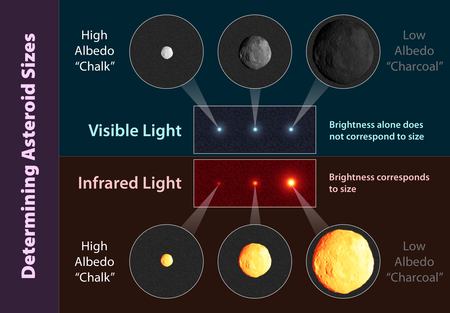Determining Asteroid Sizes

Creator: Wide-field Infrared Survey Explorer, Berkeley, CA, USA
This chart illustrates how infrared is used to more accurately determine an asteroid's size. As the top of the chart shows, three asteroids of different sizes can look similar when viewed in visible-light. This is because visible-light from the sun reflects off the surface of the rocks. The more reflective, or shiny, the object is (a feature called albedo), the more light it will reflect. Darker objects reflect little sunlight, so to a telescope from millions of miles away, a large dark asteroid can appear the same as a small, light one. In other words, the brightness of an asteroid viewed in visible light is the result of both its albedo and size.
The bottom half of the chart illustrates what an infrared telescope would see when viewing the same three asteroids. Because infrared detectors sense the heat of an object, which is more directly related to its size, the larger rock appears brighter. In this case, the brightness of the object is not strongly affected by its albedo, or how bright or dark its surface is. When visible and infrared measurements are combined, the albedos of asteroids can be more accurately calculated.
Image Use Policy: Pulic Domain

